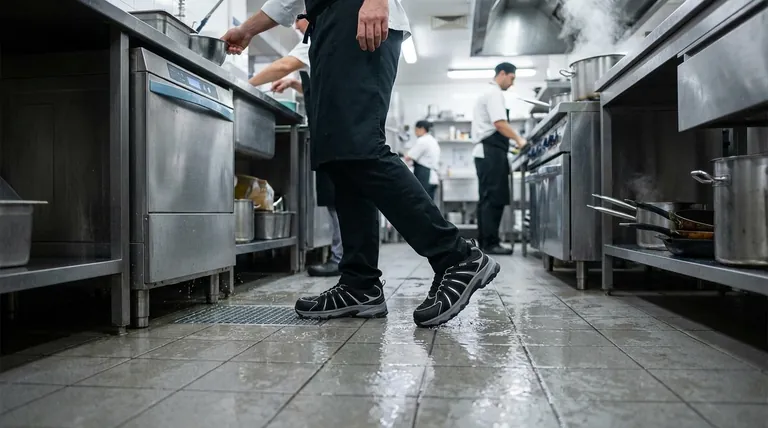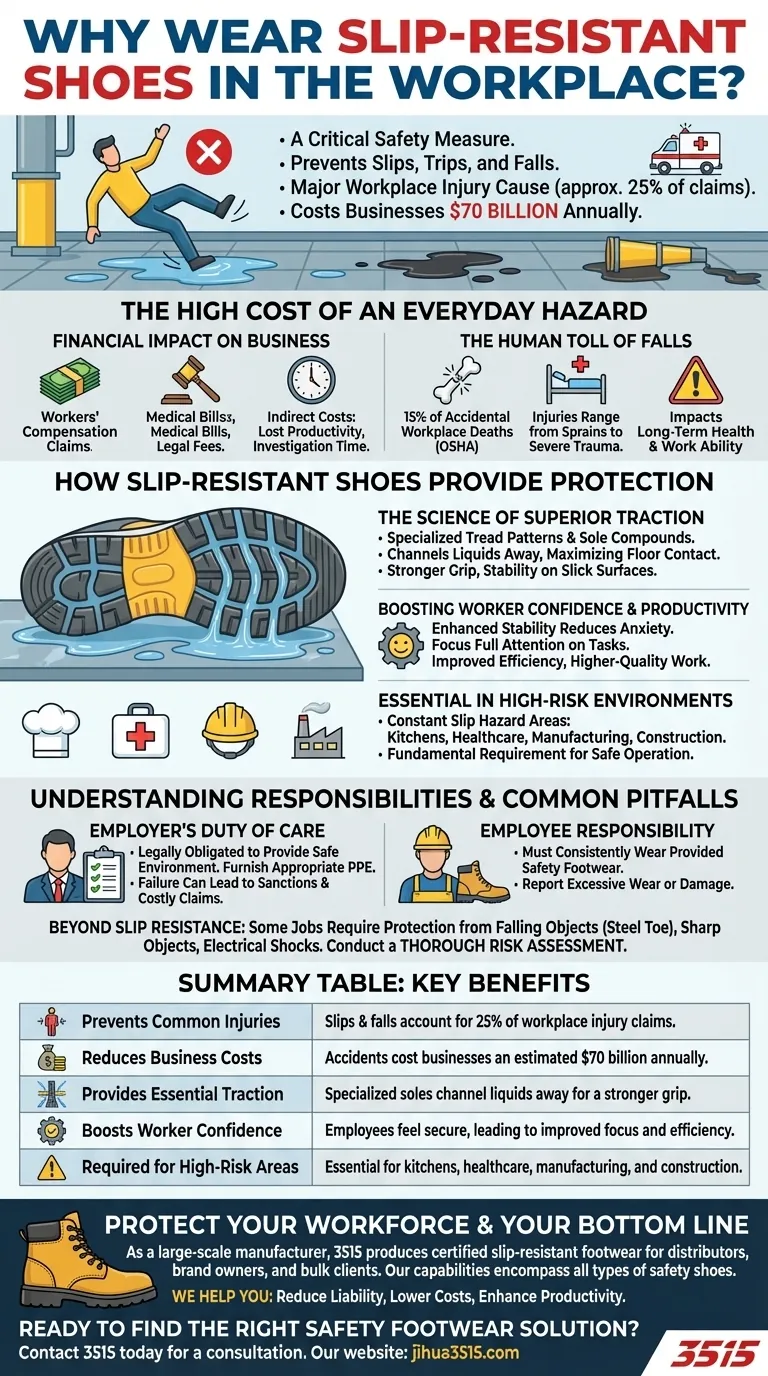Wearing slip-resistant shoes in the workplace is a critical safety measure to prevent slips, trips, and falls. These incidents are not minor issues; they are among the most common causes of workplace injuries, accounting for approximately 25% of all reported injury claims and costing businesses an estimated $70 billion annually in medical bills and workers' compensation. Proper footwear provides essential traction on wet, oily, or otherwise slick surfaces, directly mitigating this significant risk.
Slips and falls are a massive, preventable expense in both financial and human terms. Slip-resistant shoes are not just personal protective equipment; they are a core component of a safe and productive work environment, protecting employees from injury and employers from significant liability.

The High Cost of an Everyday Hazard
The true impact of a slip-and-fall accident extends far beyond the immediate event. Understanding the consequences clarifies why preventative measures like proper footwear are non-negotiable in professional settings.
Financial Impact on Business
Slips and falls are a major financial drain on companies. The costs accumulate through workers' compensation claims, medical bills, and potential legal fees.
These incidents can also lead to indirect costs, including lost productivity from an injured employee's absence and the time required to investigate the accident and implement corrective actions.
The Human Toll of Falls
The most important cost is the human one. According to OSHA, slips, trips, and falls account for 15% of all accidental workplace deaths.
Injuries can range from minor sprains to severe fractures or head trauma, potentially impacting an employee's long-term health and ability to work.
How Slip-Resistant Shoes Provide Protection
Slip-resistant shoes are specifically engineered to counteract common workplace hazards. Their design is a direct response to the conditions that cause falls.
The Science of Superior Traction
These shoes feature specialized tread patterns and sole compounds designed to channel liquids like water and oil away from the bottom of the shoe.
This design maximizes the contact between the sole and the floor, creating a much stronger grip and providing stability even on slick surfaces.
Boosting Worker Confidence and Productivity
When workers feel secure in their footing, they can focus their full attention on their tasks.
This enhanced stability reduces hesitation and anxiety, leading to improved efficiency and higher-quality work without the constant distraction of a potential fall.
Essential in High-Risk Environments
Certain industries present a constant slip hazard. Kitchens, healthcare facilities, manufacturing plants, and construction sites are often exposed to wet, greasy, or uneven surfaces.
In these environments, slip-resistant footwear is not just beneficial—it is a fundamental requirement for safe operation.
Understanding Responsibilities and Common Pitfalls
Simply having slip-resistant shoes is not enough. Both employers and employees have a role to play, and choosing the right type of shoe is critical.
Employer's Duty of Care
Employers are legally obligated to provide a safe working environment, which includes furnishing appropriate Personal Protective Equipment (PPE).
Failure to provide suitable safety shoes can result in sanctions from labor inspections and leaves the business vulnerable to costly claims in the event of an accident.
Beyond Slip Resistance
"Safety shoe" is a broad category. While slip resistance is a key feature, some jobs may also require protection from falling objects (steel toe), sharp objects (puncture-resistant sole), or electrical shocks.
A thorough risk assessment is necessary to identify all potential foot hazards in the workplace and select footwear that addresses them comprehensively.
Employee Responsibility
The protection is only effective if it's used. Employees have a responsibility to consistently wear the safety footwear provided by their employer in all designated high-risk areas.
Making the Right Choice for Your Role
The goal of safety footwear is to match the protection to the specific risks of the environment.
- If your primary focus is managing a business or safety program: Conduct a formal risk assessment to identify all foot-related hazards and invest in certified footwear that meets those specific needs to ensure compliance and reduce liability.
- If your primary focus is personal safety as an employee: Consistently wear your employer-provided footwear as required, and report any signs of excessive wear or damage that could compromise its effectiveness.
- If your primary focus is working on frequently wet or greasy floors: Ensure your shoes are specifically rated for slip resistance on oily and wet surfaces, as this is your most immediate and persistent hazard.
Ultimately, investing in the right slip-resistant footwear is a fundamental investment in safety, stability, and operational excellence.
Summary Table:
| Key Point | Why It Matters |
|---|---|
| Prevents Common Injuries | Slips & falls account for 25% of workplace injury claims. |
| Reduces Business Costs | Accidents cost businesses an estimated $70 billion annually. |
| Provides Essential Traction | Specialized soles channel liquids away for a stronger grip. |
| Boosts Worker Confidence | Employees feel secure, leading to improved focus and efficiency. |
| Required for High-Risk Areas | Essential for kitchens, healthcare, manufacturing, and construction. |
Protect Your Workforce and Your Bottom Line
As a large-scale manufacturer, 3515 produces a comprehensive range of certified slip-resistant footwear for distributors, brand owners, and bulk clients. Our production capabilities encompass all types of safety shoes and boots designed to meet the specific hazards of your industry.
We help you:
- Reduce Liability: Equip your team with reliable PPE that meets safety standards.
- Lower Costs: Prevent expensive accidents and workers' compensation claims.
- Enhance Productivity: Provide workers with the confidence and stability to perform their best.
Ready to find the right safety footwear solution for your business?
Contact 3515 today for a consultation and let our expertise work for you.
Visual Guide

Related Products
- Premium KPU Athletic Safety Shoes for Wholesale
- Durable Rubber-Soled Utility Shoes for Wholesale & Custom Brand Manufacturing
- Custom Safety Shoe Manufacturer for Wholesale & OEM Brands
- Premium Lightweight Safety Shoes for Wholesale & Bulk Orders
- Lightweight Breathable Training Shoes for Wholesale & Custom OEM Manufacturing
People Also Ask
- What are the EN ISO 20345 norms for safety shoes? A Guide to Choosing the Right Protection
- What does a green triangle symbol on safety footwear mean? Your Guide to Maximum Puncture & Impact Protection
- Why is expert help recommended when selecting safety shoes? Ensure Perfect Fit & Hazard Protection
- What materials are used in the construction of these boots? A Guide to Velour Leather, Textile & PU Soles
- Why is slip resistance important in safety footwear? Prevent Costly Workplace Slips and Falls



















